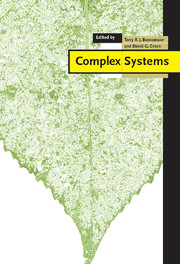Book contents
- Frontmatter
- Contents
- 1 Introduction
- 2 Self-organisation in complex systems
- 3 Network evolution and the emergence of structure
- 4 Artificial life: growing complex systems
- 5 Deterministic and random fractals
- 6 Non-linear dynamics
- 7 Non-linear control systems
- 8 Parallel computers and complex systems
- 9 Are ecosystems complex systems?
- 10 Complexity and neural networks
- Index
5 - Deterministic and random fractals
Published online by Cambridge University Press: 04 August 2010
- Frontmatter
- Contents
- 1 Introduction
- 2 Self-organisation in complex systems
- 3 Network evolution and the emergence of structure
- 4 Artificial life: growing complex systems
- 5 Deterministic and random fractals
- 6 Non-linear dynamics
- 7 Non-linear control systems
- 8 Parallel computers and complex systems
- 9 Are ecosystems complex systems?
- 10 Complexity and neural networks
- Index
Summary
Introduction
In this chapter I will discuss a mathematical framework for deterministic and random (or non-deterministic) fractals. The approach we take is via scaling laws and scaling operators, the latter also being known as iterated function systems. This gives a very attractive theory with many applications, particularly to computer graphics and to image and data compression. Various applications of fractals are discussed elsewhere in this book.
The essential ideas will first be presented by means of a number of standard examples. Readers who wish to obtain a relatively informal overview of the material can accordingly restrict themselves to §5.2 and §5.3, and to the less formal parts of the later sections. §5.4, §5.5 and §5.6 develop much of the mathematics behind these ideas. I have tried to keep the mathematics self-contained, and in particular have attempted to motivate and develop from first principles the relevant notions of metric spaces, measure theory, and probability theory. The later sections may perhaps serve as a brief introduction to some aspects of these subjects.
It is perhaps worth mentioning here one point that sometimes causes confusion. A ‘mathematical’ fractal in a certain precise sense looks the same at all scales; i.e. when examined under a microscope at no matter what magnification it will appear similar to the original object. On the other hand a ‘physical’ fractal will display this ‘self-similarity’ for only a range of magnifications or scales. The mathematical object will of course only be an accurate model within this particular range.
Examples of non-integer dimensional sets with scaling properties have long been known to mathematicians.
- Type
- Chapter
- Information
- Complex Systems , pp. 127 - 166Publisher: Cambridge University PressPrint publication year: 2000
- 3
- Cited by



